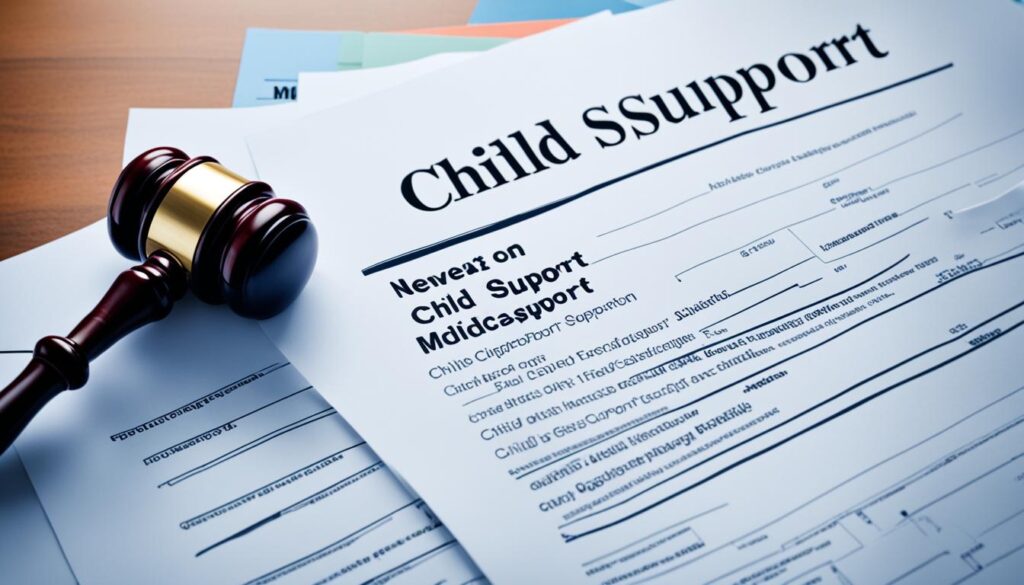Can I Get Back Child Support If I Never Filed? If you’re a parent in Texas and never asked for child support, you might still get back support. The state’s law lets courts order parents to pay back support in some cases. This raises questions: what are these cases, and how do you make this request?
In the Lone Star State, both parents should help with their child’s expenses. The amount and kind of support vary per family’s needs and what Texas law mandates. Even without a past request for support, you might ask for payments since the parents split up.
Judges in Texas typically look back four years when considering back child support, unless there are serious circumstances. Let’s say one parent hid, knew they should’ve paid but didn’t, and had the means to do so. Then, the court might look further back to decide on support.
You can’t try to get old support by complaining about a current support order. Changing an existing order requires acting fast and using the right legal steps.
Key Takeaways
- In Texas, you may get retroactive child support starting from when the parents split, even without a previous support claim.
- Judges usually limit back support to four years, but they can go further back in special cases.
- You must promptly follow proper legal steps to modify existing child support orders.
- Retroactive support differs from back support, which is unpaid support that’s already due by court order.
- Getting advice from a family law lawyer is smart if you’re seeking retroactive or back child support.
Understanding Retroactive Child Support
What is Retroactive Child Support?
Retroactive child support means the money a parent didn’t live with their child owes. It’s for the time from when they stopped living together until a court ordered child support. This helps both parents contribute financially for their child. It pays the custodial parent back for the money they spent taking care of the child alone.
Conditions for Retroactive Child Support in Texas
In Texas, a parent might have to pay late child support if they never paid before and weren’t part of a past court case about it. These rules are in the Texas Family Code Chapter 154.009.
If one parent paid all the child’s expenses on their own, they can ask for late support. They must show that the other parent should have helped but didn’t.
For late child support to be canceled, both parents must agree. Then, the court might decide to not make them pay all or part of what they owe.
Considerations for Retroactive Child Support
The court in Texas looks closely at each case to decide retroactive support. They check if parents worked together on seeing the child and on who paid for what. The aim is to see if both parents fairly chipped in, even without an official support order before.
If one parent helped out but not as much as Texas needs, the court could change things. They want to make sure the child is cared for and both parents do their part. Even without a past order, fairness matters.
Visitation and Access Arrangements
The court checks if parents helped or not in letting each other see the child back then. How they managed this affects the support decision.
Expenses Paid by Each Parent
They also see which parent paid for stuff like medical bills, school, or after-school costs. This shows how hard each parent worked, helping the court set the support amount.
Financial Cooperation Between Parents
If parents helped each other financially, like with bills or spending on the kid, the court notes this too. It can influence the support payment decision.
Looking at all these details, the court creates a support order that is fair and covers what the child needs. This way, the ruling considers the case’s specifics and puts the child first.
Retroactive Child Support Time Limits
In Texas, judges usually look back up to four years for retroactive child support. This allows parents to ask for support from the past four years. But, in some egregious circumstances, there can be exceptions to this rule.
The Four-Year General Rule
The Texas Family Code, in Chapter 154.009, sets the rules for retroactive support. To order it, the parent asking for it must not have had an earlier support agreement. Also, they must not have been in a case where support was already ordered. If these are true, a judge will likely stick to the four-year limit.
Exceptions for Egregious Circumstances
Sometimes, judges will go past the four-year rule for very egregious circumstances. An example is if one parent avoided their responsibilities, knew they were the parent, and could afford to pay but didn’t. In these serious cases, the support period might go even further back.
Judges are cautious about going too far back beyond the four-year mark. Even in extreme scenarios, they rarely extend the timeline. The four-year rule is usually what guides decisions on retroactive child support in Texas.
Can I Get Back Child Support If I Never Filed?
If you haven’t asked for child support before in Texas, you might get retroactive child support. This can go back to when the parents separated, but it usually covers the past four years. You can’t change an old child support order to ask for retroactive child support.
Under Texas Family Code Chapter 154.009, a court can order retroactive child support if it’s fair. A parent could ask for retroactive child support from the date of separation, usually for up to four years. Courts might look back further than four years if a parent tried to dodge paying child support.
Getting an attorney to help with back child support might bring legal action. This can lead to fines, jail time, or losing their license for the parent who hasn’t paid. Retroactive child support means paying from the time the parents split until the court sets the child support amount.
You can’t change an old child support order to ask for retroactive child support. So, if you want to modify child support, act quickly.
Modifying Existing Child Support Orders
You can’t go back and ask for old child support payments with a new claim. For instance, if a parent’s pay doubled after the initial support order, no retroactive charges are allowed. This shows that time is of the essence in modifying child support.
In Texas, child support can be changed if it’s been over three years since the last change and the payment is off by 20% or $100 from the guidelines. You must ask for a change at the Attorney General’s Child Support Division in Austin, TX. Changes in income, more kids, insurance updates, or child living locations can all trigger a modification request.
Remember, only the CSRP or court can adjust child support, not private deals between parents. Changing a support order might mean paying more, particularly if the paying parent makes more money now.
If you’re thinking of adjusting support, act fast. Delaying might mean missing a chance to update the order for your child’s benefit and your own financial situation.

What is Back Child Support?
Back child support is when a parent owes money for their child’s care but hasn’t paid. This could be due to missed payments or arrears. In this situation, you have legal options to get the money owed. You can ask the court to make the other parent pay the overdue support.
Court-Ordered Child Support Not Paid
When a parent doesn’t pay their court-ordered child support, it causes big problems. The parent caring for the child must bear all costs. Sadly, some non-paying parents never fulfill this financial duty.
Enforcing Back Child Support Payments
To make the other parent pay back child support, the custodial parent can seek legal help. This can include going to court. There, a judge might issue penalties like fines or jail. The court could also limit their driving or working. It is wise to talk to a family lawyer to understand your rights.
Challenges in Collecting Back Child Support
Trying to get back child support can be very hard. Some parents never pay back what they owe. This means you might spend a lot of money on legal fees for nothing. It might not be worth the time and effort.
Parents who don’t want to pay back child support might get away with it. This is very frustrating for the parent who is trying to collect overdue child support. It’s important to talk to a family lawyer. They can help you figure out your best moves.
Getting overdue child support can be tricky. Even if the law punishes the parent who doesn’t pay, they might still not pay. The legal system has limits on making them pay, and many just won’t do it.
If your child’s other parent doesn’t pay child support, you need to think hard. Should you try to get old payments through the legal system? It’s a tough call that needs a lot of thought and good advice from a lawyer.
Legal Options for Back Child Support
If the other parent isn’t paying court-ordered child support, you should talk to a family law attorney. They can help you understand your specific situation. An attorney knows the steps needed to get back child support payments.
Seeking Legal Advice
Dealing with missed child support payments? A family law attorney can guide you. They know how to take legal action to collect overdue child support. This might involve getting retroactive child support orders or other steps to catch up on child support.
The attorney will also explain what back child support eligibility and late child support claims mean. They help you understand these complex issues.
Retroactive Child Support in Pennsylvania
In Pennsylvania, a parent can ask for retroactive child support if they’ve been the only one paying for their child. This support pays back the parent for the money they already spent when taking care of the child by themselves. A parent can request this help if they have paid all the child’s expenses alone.
Eligibility for Retroactive Child Support
For retroactive child support, a parent must show the other parent should have helped with the child’s costs. They need to start a legal process by asking the court for this support. They also need to show proof of the money they spent, like bills and receipts.
Filing a Petition for Retroactive Child Support
The request for retroactive support starts from the application date, not the birth or separation date. If there’s a delay in the court hearing after the request, the back pay still starts from the application date. Parents who don’t pay might have their driver’s licenses taken away or be sent to jail. Retroactive payments can be made in one sum or in installments, based on the parent’s financial condition.
Parents can agree not to ask for retroactive support. This can happen if the other parent helped financially before the court case. The right to get child support is usually the custodial parent’s, not the child’s, even when the child is grown up. If the custodial parent dies, the child or their legal representative can try to get unpaid support.

Evidence Required for Retroactive Child Support
To get retroactive child support in Pennsylvania, the parent must show what they spent and how they supported the child in the past. They need to provide proof like bills, receipts, and bank statements. This shows the court the financial strain they faced.
Showing how money was used to support the child is key in proving the need for retroactive support. The court looks at all evidence closely. So, a detailed record of child-raising costs helps the parent’s case. It makes receiving retroactive support under Pennsylvania law more likely.
Getting retroactive support helps make sure both parents support their child financially. It makes the non-custodial parent help with the costs when they haven’t been. The proof submitted by the custodial parent is important. It not only supports the retroactive request but also makes the other parent responsible for their part.
Waiving Retroactive Child Support
In Pennsylvania, parents can agree to lessen or waive the retroactive child support. But, this needs both parties to be fine with it. The court won’t step in to start this process. They’ll only think about doing it if the parents ask together.
This way of handling things lets Pennsylvania parents figure out a mix that works for their money issues. They also have the child’s best interests in mind. By agreeing on this, they pick a path that avoids a lot of hassle.
The court won’t on its own look into cutting retroactive child support. It’s up to the parents to ask for this, showing they both are okay with it.
Pennsylvania’s way of dealing with retroactive child support shows how talking and sharing is key. Doing so helps after a difficult time of separating or divorcing. Together, parents can care for their child well and make things fair for everyone.

Retroactive Child Support in California
Retroactive child support covers unpaid support for a previous period when support wasn’t legally required. To decide on retroactive support, California courts look at the child’s raising costs, the parents’ incomes, any pre-court voluntary payments, and the 3-year time limit.
Factors Considered by the Court
California courts review both parents’ finances during the retroactive period. They look at the parents’ incomes, any pre-court voluntary payments, and the child’s raising costs. They also apply a 3-year time limit in most cases for retroactive support.
Best Interest of the Child Standard
The “best interest of the child” drives California courts’ decisions on retroactive support. They consider several factors to ensure the child’s needs are served. This includes reimbursing the custodial parent for past expenses and holding the non-custodial parent responsible financially. The main aim is a fair outcome that puts the child’s well-being first.
Steps to Seek Retroactive Child Support
If you’re a parent in California and want to recover past child support, you’ll need to follow some steps. You have to file a petition, make sure the other parent gets served the papers, and show up in court.
Filing a Petition
First, file a petition in court for retroactive child support. You’ll ask for a specific amount and list the time you’re seeking payment for. It’s good to remember that you can only ask for up to three years of back pay in California.
Serving the Non-Custodial Parent
After you file, you must make sure the other parent gets a copy of the petition. This step is important so they know about the request and the court date. If giving them the papers takes more than 90 days, the back pay starts from when they get served.
Court Hearing and Order
Next is the court hearing. The judge will decide how much retroactive child support is due and set a monthly payment amount for the future. The non-custodial parent then has to start paying the back support. They might also have to pay a 10% interest rate on the total owed.
FAQ
Can I Get Back Child Support If I Never Filed?
In Texas, both parents must help support their children as per state law. If you’ve never asked for child support, you may be able to get it retroactively. This means you can ask for support from the time when the parents first separated.
Usually, the court looks back up to four years for this kind of support.
What is Retroactive Child Support?
Retroactive child support is the money a parent needs to pay from the time of separation until a court orders support. A court can order this if support wasn’t previously ordered and the parent didn’t take part in that case.
What are the Conditions for Retroactive Child Support in Texas?
Two conditions need to be met in Texas for retroactive child support. First, no child support was ordered before. Second, the parent didn’t participate in any past support cases.
What Factors are Considered for Retroactive Child Support in Texas?
Texas courts consider several things for retroactive support. They look at how parents cooperated on visitation and who paid for different things. This includes medical expenses, education, and activities, and any money exchanged.
What is the Time Limit for Retroactive Child Support in Texas?
Generally, Texas courts go back up to four years for retroactive child support. Yet, in severe cases where the parent avoided paying despite having the means, this rule might not apply.
Can I Modify an Existing Child Support Order to Request Retroactive Support?
No, you can’t add retroactive support to a current support order later on. If you’re looking to change support levels, it’s better to act quickly.
What is Back Child Support?
Back child support is money that hasn’t been paid according to a court order. A parent can ask the court to force the other parent to pay this. This could involve legal action if the other parent doesn’t comply.
What are the Challenges in Collecting Back Child Support?
It’s hard to collect back child support. Some parents might not ever pay it. Legal fees can pile up if you’re trying to get this support through the court. It’s important to think about how much you’re willing to spend.
What are the Legal Options for Collecting Back Child Support?
If you’re facing this issue, talking to a family law attorney is your best move. They can advise you on your specific situation and the best legal steps to take.
What are the Eligibility Requirements for Retroactive Child Support in Pennsylvania?
In Pennsylvania, a parent can claim retroactive support if they’ve been the sole financial supporter of the child without the other parent’s help.
How Do I File for Retroactive Child Support in Pennsylvania?
To claim this type of support in Pennsylvania, you’ll need to file a petition with the court. This includes stating the amount you’ve supported the child and for how long you’ve been doing it.
Can Retroactive Child Support be Waived in Pennsylvania?
Yes, in Pennsylvania, both parents can agree to not seek retroactive support. However, the court won’t make this decision for them.
What Factors are Considered for Retroactive Child Support in California?
In California, the court looks at the costs of raising the child, the parents’ incomes during the period in question, pre-court order payments, and the path of the support request to a maximum of three years back.
What is the Best Interest of the Child Standard in California?
California uses the best interest of the child as its guide when deciding on retroactive support.
What are the Steps to Seek Retroactive Child Support in California?
To get retroactive support in California, the requesting parent must file a court petition. A copy must be given to the other parent. Then, there’s a court hearing to decide on the retroactive support amount.








